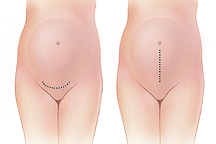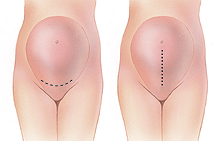Cesarean Birth (C-Section)
A cesarean birth is the surgical delivery of a baby through an incision on the mother’s abdomen. Cesarean births may be planned and scheduled. In many cases, a cesarean is unexpected. A cesarean is done to make sure that you and your baby have the safest birth.
Preparing for the birth
The preparation for the birth is nearly the same whether scheduled or unscheduled. Surgery will begin shortly after you receive anesthesia. You will receive either regional or general anesthesia. Most cesareans are completed in less than an hour. During the birth, your healthcare team is with you, ready to take care of you and your newborn. A family-centered approach called a “gentle cesarean” may be utilized for your surgery/birth. This approach allows your partner to be with you for the birth and encourages mother and baby bonding immediately after the birth.
Making the incisions
In a cesarean birth, incisions are made in both the skin and the uterus. Either incision may be transverse (from side to side) or vertical. Your skin and uterine incisions may differ. Be sure they are noted in your health records:
- The skin incision is usually transverse (side to side). It is located at the pubic hairline. A vertical incision may be used if you’ve had this incision before or if the cesarean needs to be done quickly.
- The uterine incision is almost always transverse. A transverse incision heals very well. This may allow for a future vaginal birth (VBAC). In certain cases, a vertical uterine incision may be made.

|

|
Transverse skin incision or vertical skin incision.
|
Transverse uterine incision or vertical uterine incision.
|
Your baby’s birth
Once the incisions are made, the healthcare provider presses on the top of the uterus and guides the baby through the incision. The cord will be clamped and cut. Then the placenta is lifted out through the incision.
Taking care of you
After your baby’s birth, the uterine incision is closed with stitches. Your skin incision will be closed with surgical staples or stitches and a dressing will be applied. Your healthcare provider will press on your uterus. This helps expel blood clots through the vagina. You may be given medicines to help shrink your uterus and decrease bleeding. You may also receive antibiotics to reduce any risk of infection.
Taking care of your baby
While your surgery is completed, your baby may be placed skin-to-skin on your chest. If the healthcare team needs to provide additional care for the baby he or she will be placed on an infant warmer Gentle suction will be used to help remove excess fluid from the baby’s mouth and airways. Then the APGAR score will be done. This rates baby’s appearance (color), pulse (heart rate), grimace (muscle reflex), activity, and respiration. A family-centered cesarean will allow you and your partner to have dedicated bonding time immediately after the baby is delivered.
Risks of cesarean
As with any surgery, cesarean birth has risks. Your healthcare provider will discuss the risks of cesarean with you. They may include:
- Bleeding
- Infection
- Injury to nearby organs
- Blood clots in the legs, pelvis, and/or lungs
- Reaction to anesthesia
|
© The StayWell Company, LLC. 800 Township Line Road, Yardley, PA 19067. All rights reserved. This information is not intended as a substitute for professional medical care. Always follow your healthcare professional's instructions. This information has been modified by your health care provider with permission from the publisher.